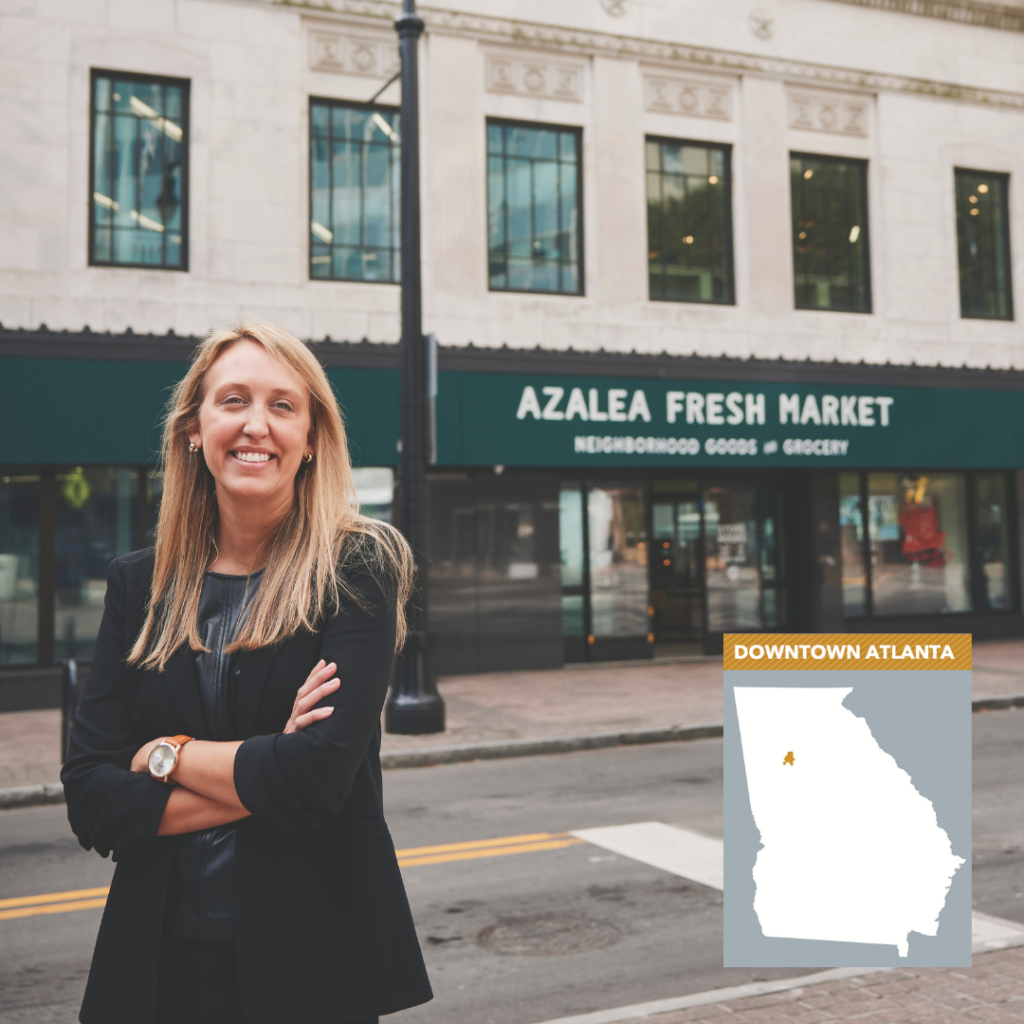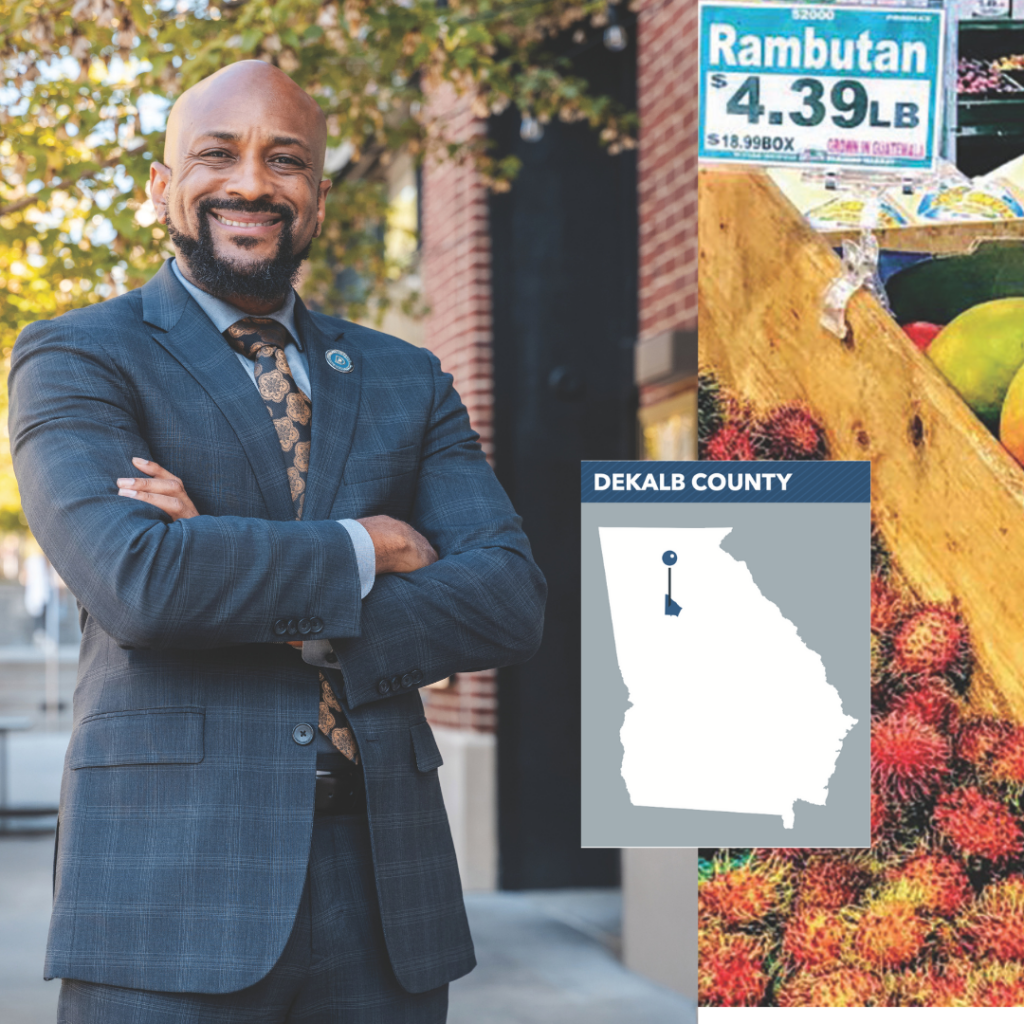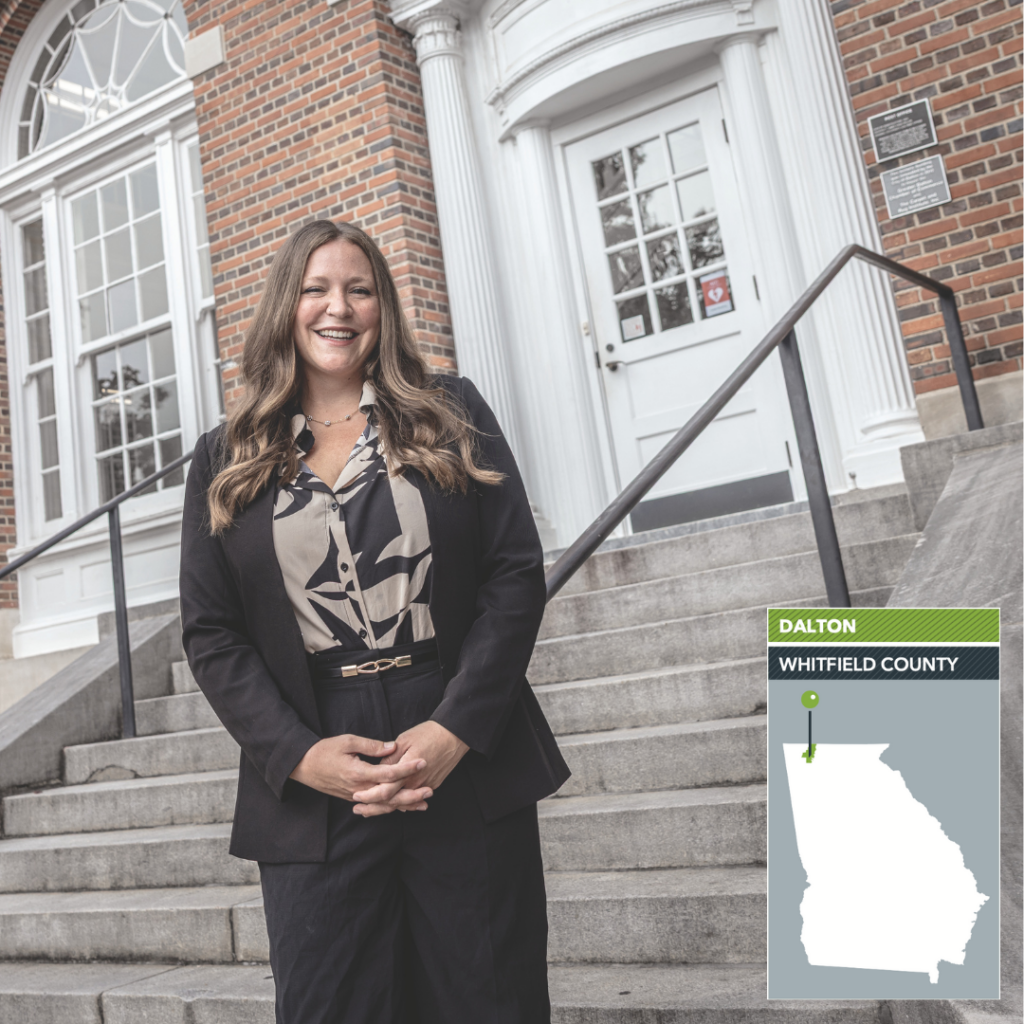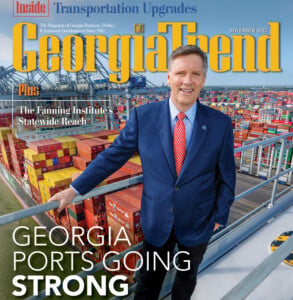Valdosta | Lowndes County: Forward Motion
Resilience, Industry, Workforce
Valdosta, which brands itself the capital of South Georgia, has had a hard go of things lately. “[For] 166 years, we never had a hurricane hold together and make it to our doorstep,” says Valdosta Mayor Scott James Matheson. Yet suddenly, within about a year, it had Idalia, Debby and Helene – and in between, a 75-mile-per-hour straight-line wind that did as much damage as Idalia, according to Matheson.
Christie Moore, president and CEO of the Valdosta-Lowndes County Chamber of Commerce, recalls that after seeing the post-Helene damage from the air, Gov. Brian Kemp said that it looked like a tornado had hit from Valdosta to Augusta. “This is the most difficult thing our community’s ever been through by far,” she says. Despite all the damage and upheaval within the Lowndes communities, they are holding strong and working together to get past the setbacks and continue bolstering all aspects of development.
A strength of the area is its diversity of industries, which helps stabilize the community, says Moore. In addition to Moody Air Force Base, SGMC Health and Valdosta State University (VSU), there are food-related producers, manufacturers of automotive parts and packaging, distribution centers and more.
From January to November 2024, the Valdosta-Lowndes County Development Authority worked on projects that added 350 new jobs and $282 million in capital investments. Announced in October 2023 was one of the area’s biggest wins ever: a Walmart milk-processing facility with a $350 million investment in Lowndes County. It is set to open later this year, with full production (using local dairy farmers’ milk) by 2026. It’s bringing with it nearly 400 jobs to serve products to more than 750 Walmart stores and Sam’s Clubs across the Southeast. Niki Ogletree, interim executive director of Valdosta-Lowndes County Development Authority, says that Walmart’s addition of jobs and capital investment will be “life-changing for the community as a whole.”

Life-changing Investment: Niki Ogletree, interim executive director of Valdosta-Lowndes County Development Authority, at the new Walmart milk-processing facility. Photo: David Parks Photography
Another key company to the area is GAF, North America’s largest roofing and waterproofing manufacturer, which will bring 135 jobs to the county by the end of 2028. The company credited Valdosta’s manufacturing capabilities for its decision to locate there.
Arglass, an innovative glass container manufacturer, is expanding its Valdosta footprint by adding a second furnace to its facility to the tune of $230 million and approximately 100 more jobs. Construction is set to be completed in the second quarter of 2025.
As a true community health system, SGMC Health makes a big impact on the community – medically, professionally and economically, with an annual economic impact of over $1 billion. “We’re of the community, for the community, to provide the responsible services to the community,” says Ronald Dean, president and CEO of SGMC Health. “We’re just simply responding to what the market has said it desires.” And to further reflect the desired level of care, the main campus is currently undergoing a $150 million expansion project expected to be completed in late 2026 or early 2027. Improvements include a new tower to house services for women and infants, and a new emergency room and trauma center.

Bringing Jobs: GAF, a roofing and waterproofing manufacturer, plans to hire 135 people by the end of 2028. Photo: Contributed
To further small-business growth, the chamber of commerce supports the SEEDS (Sowing Entrepreneur and Economic Development Success) Business Resource Center, which aids business owners in their ventures and provides customized research and data. Even those who are not chamber members can visit the center to talk out ideas and get feedback for free – which Moore says is a rare commodity.
The area’s successful recruiting and growth is often due to combined efforts. Paige Dukes, county manager of Lowndes County, says, “I think that we are very good at un-siloing so that people can work across demographics and party lines and city limits and county lines to look at what resources we have here in South Georgia, and how can we all work together to maximize those to bring that growth here.”
Places to Call Home

Revitalizing the Region: Rendering of Harvest Station apartments, an affordable housing program. Photo: Contributed
Excitement surrounds an affordable housing project that Valdosta is building with real estate development firm IDP Properties. Harvest Station apartments, an affordable housing program, will help revitalize a previously blighted area. Phase 1 broke ground in February 2024 and Phase 2 was approved in late 2024, with Lowndes County committing $1 million toward the project. Completion of Phase 2 will bring the total units to 170.
The ribbon cutting for Phase 1 is planned for early this year, according to Matheson. Then will come a groundbreaking for Phase 2 of the project. Harvest Station is adjacent to a 9-acre park with a fishing pond and a recently renovated library and across the street from SGMC Health’s Partnership Health Center, a low-/no-cost healthcare and prescription clinic. “So now you have a very livable, walkable corridor,” says Matheson, who indicated the projects that followed were a godsend. Those included Dollar General’s DG Market coming in near Harvest Station and the Georgia Department of Transportation working to realign a dangerous key intersection. Once this project is complete, the mayor says that then IDP Properties will get going on another development: workforce housing to support the Walmart milk-processing facility.
Not only is housing affordability a challenge the area is working on, but so is housing availability in general. “We have a housing shortage,” says Matheson. “We can’t build it fast enough. We have some great builders, but we also had D.R. Horton just show up. They’ve committed to 1,000 homes in our area [including] the city and the county. They’re building one of the largest projects we’ve had in 30 years in the city limits, of over 100 homes.”
Industry Insights for Students

Big Impact: SGMC staff joined state and local leaders for the September 2024 groundbreaking of the hospital’s main campus expansion. Photo: Contributed
It can be hard to maintain an adequate workforce, especially in rural areas. To help ensure enough workers in the future, Valdosta and Lowndes County emphasize teaching high school students about local jobs and industries they may not know about.
The chamber works on CTAE (Career, Technical & Agricultural Education) for students. And the Valdosta-Lowndes County Development Authority hosts CTAE tours of industries for both instructors and students. In each instance, the groups tour a couple of industries to see what fields and jobs are available locally, which helps encourage students to stay within the local workforce. “To see [students’] faces when they realize what’s available here in Lowndes County or what we produce here in Lowndes County, it’s phenomenal,” says Ogletree.
Wiregrass Georgia Technical College has had a 3% increase in students who take classes while in high school through dual enrollment and then continue beyond. The college has strong partnerships with the local high schools. “The dual enrollment continues to be a big part of our student body,” says Wiregrass President DeAnnia Clements. “It’s really opening up doors for the students to get those core classes that they may need to go into a bachelor’s program.” It also gives them an opportunity to explore occupational programs and identify skill-set options for getting a job locally.

Increasing Healthcare Programs: DeAnnia Clements, president of Wiregrass Georgia Technical College, at the school’s nursing simulation lab. Photo: David Parks Photography
Wiregrass’ Wired for Workforce Program is a collaboration with the Valdosta-Lowndes County Development Authority. “The [Development Authority leaders] have their finger on the pulse of what business and industry is coming into our area and what our current business and industry needs, so we work closely with them,” says Clements. The program is led by Wiregrass’ economic development team, which oversees a five-day course for high school seniors. “At the end of the week, they’re able to graduate, and they basically have all the certificates needed to be workforce ready to go into our industries and work,” says Ogletree. Students learn skills and complete national certification with OSHA 10-hour general industry classes. The students get prepared in other ways as well, including mock interviews with industry partners.
Targeting Workforce Needs
Wiregrass focuses on addressing the needs of local industries and businesses, which also helps keep students in the region. “They become part of that workforce in South Georgia and allow us to continue to attract business and industry here in South Georgia,” says Clements. Program instructors meet with the local businesses and industries to find out what they need and how they need it. Then, the college incorporates that information – or key piece of equipment – into its program area. The Wiregrass team also uses various software tools to help identify what positions will likely be needed in South Georgia, and therefore how to adjust their programs, says Clements.
Wiregrass is working to increase its number of healthcare programs, which are particularly needed in South Georgia. The college now has an Associate of Nursing program and a Medical Laboratory Technology program that helps students find careers as medical lab technicians. SGMC Health has partnered with Wiregrass and Valdosta State to help address needs and shortages, such as of nurses and physicians. “We not only provide our facilities for clinical training, but we partner with them in many ways to make sure that they have the resources they need to attract students to train as nurses, for example, but it doesn’t stop there,” says SGMC Health’s Dean.

Using Resources: The College of Nursing and Health Sciences recently used a grant to purchase 11 state-of-the-art “manikins,” lifelike human replicas that simulate patients with medical problems. Photo: Contributed
“We [at VSU] are actively always thinking about how to make South Georgia better,” says Valdosta State University President Richard Carvajal. The university is currently making transformative changes through a new strategic plan called VSU2030. “What does the university of 2030 need to look like? That was the question we spent a good bit of time trying to answer,” says Carvajal. In answering that question, low-demand programs were discontinued, and those desired by prospective students and employers were added.
Bringing Everyone Together
It involved some starting and stopping over a course of years for various reasons (including the pandemic), but in 2023, One Valdosta-Lowndes (OVL) officially launched. The initiative unites civic, public and private organizations to enhance economic development and quality of life and work toward common goals of the community. “There are some things that are of benefit to our community and our county and our region that we can only best do if we do them together,” says Carvajal, an OVL board member.
OVL’s strategic plan for economic development includes three core initiatives: civic engagement and leadership; pathway to prosperity; and vibrant and safe community. Based on the goals within these initiatives, OVL anticipates an annual economic impact of $12.7 million, according to its director, Mary Beth Brownlee. But of course it often takes some money to bring in money. “To do the type of work we were wanting to do, we knew we’d have to do a capital campaign,” says Brownlee. That campaign had raised $2.2 million as of September 2024 (with an overall goal of raising $3.5 million), but when Hurricane Helene came calling, the campaign paused. To Brownlee’s surprise, OVL’s board wanted to quickly get back to raising funds. “Even this huge, unprecedented national natural disaster has not [lessened] their commitment,” Brownlee says. “And in a lot of ways, I think the community sees the value in what we’re going to be doing even more so.”
OVL anticipates kicking off its 2025 plans with a fundraising project for Troupville River Camp and Nature Park. Long-term goals include creating a regional college and career academy (to enhance workforce competitiveness within 10 counties in South Georgia and North Florida), and focusing on housing, guided by an affordable housing study and redevelopment strategy from Georgia Tech’s Center for Economic Development Research.
Visitor Draws
According to Georgia’s Economic Impact of Tourism report, visitor spending in Lowndes was $422.3 million in 2023. That was up from $387 million the previous year. David DiSalvo, president and CEO of Visit Valdosta, the city’s tourism authority, notes that people often don’t realize the economic impact of visiting places, which is especially missed during and after a natural disaster.

Tourism Spending Up: Recoil Trampoline Park, above left, draws people in with its trampolines, trapeze, arcade and laser tag; David DiSalvo, president and CEO of Visit Valdosta, above right. Photos: Visit Valdosta
A popular tourism destination in the region, Wild Adventures theme park, had some damage from Hurricane Helene but reopened to begin its Great Pumpkin LumiNights event the first week of October. Just before Helene hit, the park had opened a new campground, including cottages, tent camping and RV sites; and in 2025 it is expanding its Water’s Edge area.
The region’s mild climate allows people to play golf year-round at courses such as Kinderlou Forest and Stone Creek. And when the weather’s not cooperating, Fairway Tavern has an indoor golf simulator, and Downtown Social offers bowling, shuffleboard, darts and other indoor sports. Recoil Trampoline Park has trampolines plus a trapeze, an arcade and laser tag. The Annette Howell Turner Center for the Arts has classes including glass mosaics, flameworking and glassblowing, and it is opening a new children’s museum later this year.
One of the area’s more innovative spots is Valdosta Wake Compound, a 30-acre facility with custom-developed ponds and a cable system for wakeboarding. Residents and tourists alike visit to wakeboard at the facility or attend summer camps or competitions. In 2024, the facility added an aqua park (essentially a floating obstacle course) to cater to those beyond wakeboarders. Luke Tilt, a co-founder and co-owner, credits the community with the site’s success, and he is happy to share that success. “I’m all about small business,” he says. “I’m all about Valdosta.” In addition to supplying jobs, he supports the region in other ways. “I work with Visit Valdosta. … I also pay hotel-motel tax for anybody that stays on-site at my spot. … So if we make money, they make money.”
All these attractions, plus numerous new restaurants and shops, are synergistically driving the area’s tourism. DiSalvo says he wants visitors to realize how much the area has to offer and maybe even extend their stay. “We had a billboard that said, ‘Florida’s full. Visit Valdosta. Stay in Valdosta,’” says DiSalvo. “If you’re driving through, come on, spend one night with us or maybe multiple nights because now, once you get here, you’re going find out how much there is to do.”
Despite the hurricane devastation in Valdosta and Lowndes County, there is hope, excitement and progress – even at Valdosta State, which was hit exceptionally hard. “We always say around here as the [VSU] Blazers that a blaze always burns brightest in the dark,” says Carvajal. “That’s a slogan we’ve used for a long time. Well, it’s had new meaning … as we have begun to recover from this. And it is something that we’ll be dealing with for a while, but we know we’ll be OK.”
Local Flavor
Courthouse in Session
Downtown Valdosta recently regained a treasured building when it restored the Historic Lowndes County Courthouse on East Central Avenue. Originally built in 1905, the courthouse was designed in a Neoclassical Revival style by architect Frank P. Milburn. In 1980, the Lowndes County Courthouse was placed on the National Register of Historic Places for its architectural qualities.
The building sat empty for almost 12 years before the renovation, which was funded by a $10 million Special Purpose Local Option Sales Tax (SPLOST). “I think that historic courthouse has been a fantastic example of why that tax was created and how it can work very well,” says Paige Dukes, county manager.
Now, visitors can take a 20-minute tour to learn about the restoration and area history. More than 4,000 visitors – many from outside the region and even the country – toured the location within the first year after completion.
“Not only is it open for tours,” says Dukes, “but we’ve seen a reengagement from our legal community.” The space is available at no charge during regular business hours, so local attorneys are doing depositions there, and schools are using the courtroom for mock trial practices.
There’s also some fun: “We found out that, years ago, you could get legally married in Georgia a year younger than you could in Florida,” says Dukes. “And since we’re the last county on I-75 before you cross into Florida, there were a lot of Florida residents that came to Georgia to get married in our courthouse.”
Those people are now visiting the building and recreating pictures taken inside the courthouse decades earlier. “And it’s so cool to see them because they come in that front door, and they make a hard left,” she says. “They know exactly where they’re going.” Dukes says the courthouse is helping to draw people to downtown, giving historical inspiration and adding a quality-of-life component.
“All of the pillars that you hope expand in a healthy community environment are happening through that facility.”
With the renovation of the historic courthouse and another $25 million spent on the new courthouse across the street about 15 years ago, Dukes points out that, right now, Lowndes County is the city’s largest investor. It’s just another example of the city and county coming together for progress. 












